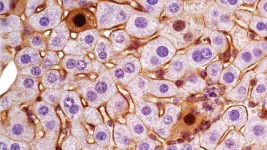(Press-News.org) ATLANTA—Plans are underway to add a seventh movable telescope to Georgia State University’s Center for High Angular Resolution Astronomy— known as the CHARA Array—that would increase the resolution, or the ability to see small objects, by a factor of three.
Located at Mount Wilson Observatory in Southern California and operated by Georgia State, the new telescope will be connected using fiber optics to transport the starlight, a technique that will serve as a pathfinder for future expansion of the Array. The update comes after a group of international scientists gathered in Atlanta to take part in the 2023 CHARA Science Meeting to share the latest developments in high-resolution astronomical imaging using the CHARA Array.
“Adding a seventh moveable telescope to the Array represents a great leap forward in stellar astronomy,” says Doug Gies, Regents’ Professor of Physics and Astronomy and director of the center. “Collaboration is truly fundamental for an undertaking like the CHARA Array. With scientists all over the world using our telescopes, this annual gathering is an important forum for us to share our latest discoveries.”
The CHARA Array combines the light from six optical telescopes spread across the mountaintop to image stars with a spatial resolution equivalent to a single telescope 331 meters (over 1000 ft) in diameter. The visible and infrared observatory offers astronomers the opportunity to capture images of space with better resolution than any other telescope in the world.
More than 40 members of the CHARA Consortium, which represents 10 institutions around the world, took part in the annual review of the latest scientific and technical progress.
Scientists gathered at Georgia State University in March 2023 for the CHARA Science Meeting and Imaging Workshop.
CHARA features a new suite of instruments built by partner institutions at the University of Michigan, University of Exeter, and Observatoire de la Côte d’Azur in France. This next generation of instrumentation provides unprecedented capabilities to image the surfaces of stars and their circumstellar environments at a variety of different wavelengths from the near-infrared to the visible part of the spectrum. Georgia State University is also building a new instrument that will increase the sensitivity of the CHARA Array to measure light 30 times fainter than possible now. This improvement will help astronomers probe the gas clouds swirling around supermassive black holes in very distant active galaxies.
With funding from the National Science Foundation (NSF), CHARA has expanded its user base over the last six years by offering open access time to the global community of astronomers through a competitive proposal process offered through the National Optical-Infrared Astronomy Research Laboratory. In addition to over 60 active observers at Georgia State University and partner institutions, the open-access program has received applications from over 350 visiting astronomers around the world.
“Expanding the user community brings new opportunities for innovative science projects that broaden the impact and productivity of the CHARA Array,’’ says Gail Schaefer, Director of the CHARA Array.
At the recent meeting, members presented some science highlights and findings from the CHARA Array.
Georgia State graduate student Katherine Shepard presented results on a sample of evolved massive binary star systems surrounded by outflowing disks. The disks in these fascinating systems form as one star in the system grows in size as it evolves and material from that star is transferred to the companion. Some of the mass escapes into a disk that surrounds the system. Katherine is using the CHARA Array to resolve the structure of these disks and search for interactions between the disk and the inner binary system.
Noura Ibrahim, a graduate student from the University of Michigan, imaged the ring-like structure of a circumstellar disk around the young star V1295 Aquila. Two images taken one month apart show a bright spot in the ring that rotates between the two epochs. This variation could be caused by a stellar companion, an exoplanet in formation, or asymmetries in the density distribution.
Visiting astronomer Willie Torres at the Harvard-Smithsonian Center for Astrophysics mapped the orbits in the Castor multiple star system. The system consists of Castor A and B that revolve around each other every 450 years, and each component in turn are short-period binary systems with periods of a few days. They are joined by a more distant component Castor C, which is also a binary. Torres used the CHARA Array to resolve the close, faint companions in Castor A and B for the first time. He combined these observations with historical observations spanning the past three centuries to map the orbits of the stars in the Castor system and measure their stellar masses with a precision better than 1%. The CHARA observations were also used to measure the radii of the two brightest stars to infer an age for the system of 290 million years.
Rachael Roettenbacher, a Postdoctoral Associate from the University of Michigan, presented recent work on mapping starspots over a rotation cycle for the sun-like star Epsilon Eridani, which is orbited by an exoplanet. The starspot images, in combination with data from other telescopes, were used to develop a technique to distinguish between small changes in the stellar spectrum caused by starspots and those caused the orbiting planet. These techniques will improve the detection of planets around other stars.
The annual meeting was followed by a workshop on imaging and modeling of interferometric observations. Participants were given an overview of modeling and imaging software packages available to analyze data from stellar interferometers (arrays of telescopes that combine light together), and the workshop included interactive hands-on sessions where participants used the software tools to analyze data. Participants also brought their own data for review in order to get the most from observations made with the CHARA Array.
END
Navigating the cosmos with Georgia State’s CHARA Array
New instruments and plans for a seventh telescope at Georgia State’s CHARA Array will allow scientists to see the stars in greater detail than ever before.
2023-04-10
ELSE PRESS RELEASES FROM THIS DATE:
BU doc honored by the Association of University Radiologists
2023-04-10
(Boston)— Priscilla J. Slanetz, MD, MPH, professor of radiology at Boston University Chobanian & Avedisian School of Medicine, was awarded the 2023 Association of Program Directors in Radiology (APDR) Achievement Award at the Association of University Radiologists’ annual meeting. The honor is given for outstanding service to APDR or to someone who has made significant contributions to the advancement of education in radiology.
Slanetz is a practicing breast radiologist at Boston Medical Center specializing in all aspects of breast imaging including screening, diagnostic evaluation and image-guided intervention, providing breast care to Boston’s most vulnerable ...
BU researcher awarded $1.5 million NIH grant
2023-04-10
Boston—Esther Bullitt, PhD, associate professor of pharmacology, physiology & biophysics at Boston University Chobanian & Avedisian School of Medicine, was awarded $1.5 million from the National Institutes of Health that will go toward the purchase of a cryogenic electron microscope. Additional funds have been pledged by University President Robert A. Brown and Professor and Chair of Pharmacology, Physiology & Biophysics Venetia Zachariou, PhD.
The FEI ThermoFisher Glacios-2 cryo-EM is capable of determining structures at near-atomic resolution. Researchers will use this new instrumentation to study cellular function and dysfunction, and to guide ...
New UK data system will help predict and prevent opioid overdoses in Kentucky
2023-04-10
LEXINGTON, Ky. (April 10, 2023) — University of Kentucky researchers are creating an innovative statewide surveillance system to inform prevention and response efforts aimed at reducing the burden of opioid use disorder in Kentucky.
The Rapid Actionable Data for Opioid Response in Kentucky (RADOR-KY) will use data from federal, state, and local sources to guide evidence-based practices aimed at preventing opioid overdoses in the Commonwealth. Phase one of the project is supported by a three-year $3.1 million grant from the National Institute on Drug Abuse (NIDA).
Driven by the COVID-19 pandemic and illegally manufactured fentanyl, drug overdose ...
AACR announces recipients of the 2023 AACR June L. Biedler Prize for Cancer Journalism
2023-04-10
PHILADELPHIA – The American Association for Cancer Research (AACR) is pleased to announce the recipients of the 2023 AACR June L. Biedler Prize for Cancer Journalism in the following categories:
Auditory Journalism
“‘No Mercy’ Chapter 5: With Rural Hospital Gone, Cancer Care Means a Daylong Trek”
Sarah Jane Tribble (Photo), Taunya English (Photo), Kaiser Health News
Greg Munteanu (Photo), Saint Louis Public Radio
Magazine
“One Man’s Search for the DNA Data That Could Save His Life”
By ...
Identifying cancer genes’ multiple personalities
2023-04-10
Mutations in our genes can lead to severe problems, like colon or liver cancer. But cancer is very complex. Mutations in the same genes can lead to different subtypes of tumors in different people. Currently, scientists don’t have a good way to produce such tumor subtypes for study in the lab.
Now, Cold Spring Harbor Laboratory Assistant Professor Semir Beyaz has created a new method to model certain liver cancer tumor subtypes using the gene-editing tool CRISPR-Cas9.
Genes contain the information our bodies need to create proteins. Highly similar proteins produced from the same gene are called isoforms. Different isoforms generate ...
Recent advances in mushroom research
2023-04-10
So, mushroom-zombies recently took over a fictional world, but in real life, they’re really not so scary. These fungi range in shape from broad, plate-like portobellos and gangly enokis to a version resembling a giant, shaggy lion’s mane. And now scientists are finding ways to grow mushrooms on new materials, as well as incorporate them in more sustainable products. Below are some recent papers published in ACS journals that report insights into additional applications for mushrooms. Reporters can request free access to these ...
Giant, swimming mouths: Oral dimensions of extant sharks do not accurately predict body size in Dunkleosteus terrelli (Placodermi: Arthrodira)
2023-04-10
A new study by Case Western Reserve University PhD student Russell Engelman published in PeerJ Life & Environment attempts to address a persistent problem in paleontology – what were the size of Dunkleosteus and other late Devonian arthrodire placoderms. Arthrodire placoderms are extinct fishes with had armor covering their head and part of their torso, but like sharks the rest of their skeleton was made of cartilage, meaning most of their body did not preserve when they became fossilized.
Previous size estimates for Dunkleosteus were ...
Scheduled childbirth may greatly reduce preeclampsia, a leading cause of maternal death
2023-04-10
Research Highlights:
Analysis found that more than half of preeclampsia cases that occur during weeks 37-42 of pregnancy (called at-term preeclampsia) may be prevented with timed birth, such as a scheduled induction or Cesarean delivery.
Planned labor inductions and Cesarean deliveries are already widely practiced for a range of reasons, however, they are seldom considered as an intervention to prevent at-term preeclampsia, which may be life-threatening.
Embargoed until 4 a.m. CT/5 a.m. ET Monday, April 10, 2023
DALLAS, April ...
Non-biological factors and social determinants of health important in women’s CVD risk assessment
2023-04-10
Statement Highlights:
A new American Heart Association scientific statement reviews research about racial and ethnic differences in cardiovascular risk factors among women in the U.S.
In addition to traditional risk factors, women of underrepresented races or ethnicities experience challenges in the diagnosis and treatment of cardiovascular conditions due to language barriers, discrimination, difficulties in acculturation or assimilation, lack of financial resources or health insurance, or lack of access to health care.
Women of racial and ethnic backgrounds other than white have been underrepresented ...
Study finds record-breaking rates of sea-level rise along the U.S. Southeast and Gulf coasts
2023-04-10
Sea levels along the U.S. Southeast and Gulf coasts have been rapidly accelerating, reaching record-breaking rates over the past 12 years, according to a new study led by scientists at Tulane University.
In the study, published in Nature Communications, researchers said they had detected rates of sea-level rise of about a half an inch per year since 2010. They attribute the acceleration to the compounding effects of man-made climate change and natural climate variability.
“These rapid rates are unprecedented over at least the 20th century and they have been three times higher than the global average over the same period,” says Sönke ...
LAST 30 PRESS RELEASES:
Making lighter work of calculating fluid and heat flow
Normalizing blood sugar can halve heart attack risk
Lowering blood sugar cuts heart attack risk in people with prediabetes
Study links genetic variants to risk of blinding eye disease in premature infants
Non-opioid ‘pain sponge’ therapy halts cartilage degeneration and relieves chronic pain
AI can pick up cultural values by mimicking how kids learn
China’s ecological redlines offer fast track to 30 x 30 global conservation goal
Invisible indoor threats: emerging household contaminants and their growing risks to human health
Adding antibody treatment to chemo boosts outcomes for children with rare cancer
Germline pathogenic variants among women without a history of breast cancer
Tanning beds triple melanoma risk, potentially causing broad DNA damage
Unique bond identified as key to viral infection speed
Indoor tanning makes youthful skin much older on a genetic level
Mouse model sheds new light on the causes and potential solutions to human GI problems linked to muscular dystrophy
The Journal of Nuclear Medicine ahead-of-print tip sheet: December 12, 2025
Smarter tools for peering into the microscopic world
Applications open for funding to conduct research in the Kinsey Institute archives
Global measure underestimates the severity of food insecurity
Child survivors of critical illness are missing out on timely follow up care
Risk-based vs annual breast cancer screening / the WISDOM randomized clinical trial
University of Toronto launches Electric Vehicle Innovation Ontario to accelerate advanced EV technologies and build Canada’s innovation advantage
Early relapse predicts poor outcomes in aggressive blood cancer
American College of Lifestyle Medicine applauds two CMS models aligned with lifestyle medicine practice and reimbursement
Clinical trial finds cannabis use not a barrier to quitting nicotine vaping
Supplemental nutrition assistance program policies and food insecurity
Switching immune cells to “night mode” could limit damage after a heart attack, study suggests
URI-based Global RIghts Project report spotlights continued troubling trends in worldwide inhumane treatment
Neutrophils are less aggressive at night, explaining why nighttime heart attacks cause less damage than daytime events
Menopausal hormone therapy may not pose breast cancer risk for women with BRCA mutations
Mobile health tool may improve quality of life for adolescent and young adult breast cancer survivors
[Press-News.org] Navigating the cosmos with Georgia State’s CHARA ArrayNew instruments and plans for a seventh telescope at Georgia State’s CHARA Array will allow scientists to see the stars in greater detail than ever before.



